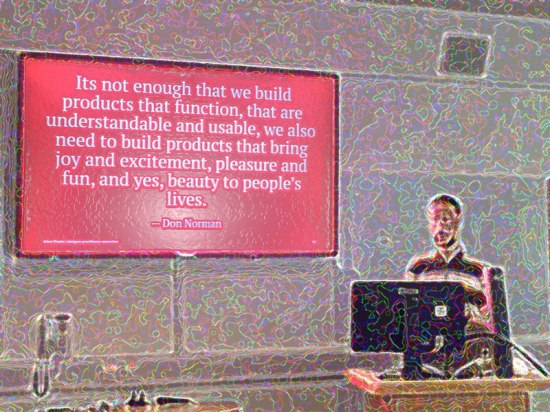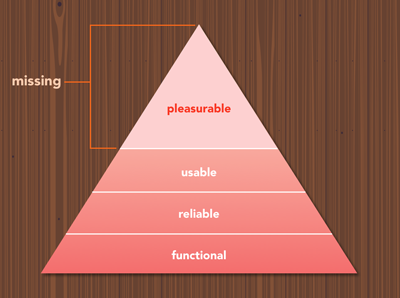decentralised – delightful – digital
May 18, 2017 at 2:11 pm | Posted in event | Leave a commentTags: #procterphd, design

Yesterday I went to see my colleague Adam Procter give a talk about his ongoing PhD research in Web Science. Adam is Programme Leader for Games Design and Art at our Winchester School of Art and always has interesting things to say about the intersections of learning, technology, design and culture. You can view the slides on his website.
He started with a provocative question “Why are the digital tools used by tutors so terrible, and why can’t anyone fix this?”. He graphically showed this by contrasting the 2-minute 20-click process required to upload and announce a PDF using Blackboard and the 10-second drag-and-drop equivalent using Slack. This wasn’t an entirely fair comparison as Blackboard stored the PDF in structured folders, while in Slack the PDF was an item in a linear timeline – and the latter approach makes it hard to find resources later, especially if keyword search is poor. For example if the PDF is called Lecture 5 Design Theories a search may find dozens of messages with one or more of those keywords. But the tutor could spend a further 10 seconds to drag-and-drop the PDF to a DropBox folder, thus enabling learners to also access and browse structured resources.
The first section of his talk focused on arguments for decentralised systems to support learning. A key concern is the way in which the dominant, centralised web companies (Google, Facebook and Twitter) track our interactions to commoditise our data and individualise (and constrain) our experience. This can be a good thing, but as we discovered during the Brexit campaign, it also led to “information bubbles” and the viral spread of fake news. In the education world, learning analytics privilege things that can be easily measured, which are not necessarily the things that really matter.
I make the case that digital technologies are being imposed upon formal learning environments, particularly focused within HE and often associated with the ‘student experience’ agenda. This imposition often reflects what amounts to a thoughtless approach to teaching and learning, in which pedagogy is side-lined by neo-liberal practices of efficiency and surveillance.
Alan Bainbridge (2014) Journal of Learning Development in Higher Education
You can join the discussion about decentralised services on Adam’s research website.
The second section explored delightful design, and after a brief ghost-train ride through the everyday horrors of some of our institutional systems moved swiftly on to some examples of playful and elegant UI and UX (user interface and user experience). I particularly liked this diagram showing Aaron Walter’s hierarchy of user needs.
 < I feel I ought to confess that writing this blog post is definitely a displacement activity to put off the awful moment when I need to continue developing our new Digital Learning website using SitePublisher, perhaps the most user-hostile system I’ve ever had the misfortune to encounter. >
< I feel I ought to confess that writing this blog post is definitely a displacement activity to put off the awful moment when I need to continue developing our new Digital Learning website using SitePublisher, perhaps the most user-hostile system I’ve ever had the misfortune to encounter. >
I think that most of the delightful examples he showed are a result of three convergent factors; apps that need to do just one thing (excellently), hardware that easily supports animated interfaces, and authoring tools that simplify the creation of those interfaces. There is also a greater focus on designing UI and UX that guide users through process flows, such as booking an airline ticket. For example, I recently came across a great blog post by Issara Willenskomer on the 12 principles of UX in motion to improve usability.
In the final section, Adam introduced an early prototype for a digital tool to support learning. This involved linked nodes of information and reminded me conceptually of some of the visual tools I have played with over the years – in particular The Brain and the excellent (and free) CmapTools. My current go-to visual organisation tool is MindMeister, which enables sharable mind-maps. I thought his prototype focused too much on content creation and lacked support for social learning, but hey, it’s early days yet.
I also think that familiar tools and systems are more likely to be adopted than bespoke solutions – so at the moment I’m looking at the new Office 365 and thinking what a great learning environment it would make, with its seamless integration of file storage, communication and collaboration… plus some really neat content creation tools such as OneNote and Sway. Some features (Teams, Planner) are ‘very similar’ to popular tools but that’s a good thing (unless you are Slack or Trello). It’s also a million miles away from being a decentralised service, but Microsoft really seem to be paying attention to the user experience – maybe not delightful, but pretty good and getting better all the time. So to finish with another provocative question “Which IT company do you think is bringing the most exciting innovations to market at the moment, and would you trust them with your data?”
Create a free website or blog at WordPress.com.
Entries and comments feeds.



You must be logged in to post a comment.